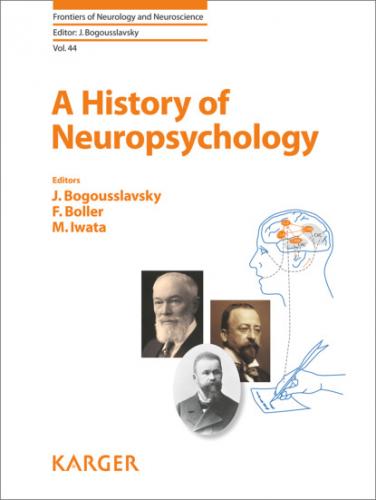29Ruffieux N, et al: Successful neuropsychological rehabilitation in a patient with cerebellar cognitive affective syndrome. Appl Neuropsychol Child 2017;6:180–188.
30Aboulafia-Brakha T, et al: Feasibility and initial efficacy of a cognitive-behavioural group programme for managing anger and aggressiveness after traumatic brain injury. Neuropsychol Rehabil 2013;23:216–233.
Jean-Marie Annoni
Neurology Unit, Fribourg Hospital
Chemin des Pensionnats 2-6
CH–1700 Fribourg (Switzerland)
E-Mail [email protected]
Bogousslavsky J, Boller F, Iwata M (eds): A History of Neuropsychology.
Front Neurol Neurosci. Basel, Karger, 2019, vol 44, pp 23–29 (DOI: 10.1159/000494948)
______________________
Anatomical Error of Pierre Marie’s “Zone Lenticulaire”
Makoto Iwata
Tokyo Women’s Medical University, Tokyo, Japan
______________________
Abstract
In a series of papers which appeared in 1906, Pierre Marie advanced a new concept of aphasiology against the classical view based on functional localization of cerebral cortex. He denied the role of Broca’s area in language function and proposed as the center for articulation “zone lenticulaire,” the lesion of which causes anarthria. But his illustration of “zone lenticulaire” which appears repeatedly in his papers dealing with aphasia, is anatomically incorrect since the most important portions of Broca’s area, opercular part and triangular part of the inferior frontal gyrus are missing in his illustration. The detailed anatomical investigation of Marie’s illustrations reveals that he repeated the same errors in identifying rolandic and frontal opercula. But the similar mistake of identifying these opercula is also seen in Dejerine’s “Anatomie des Centres Nerveux.”
© 2019 S. Karger AG, Basel
Pierre Marie’s “Zone Lenticulaire”
In 1906, Pierre Marie published a series of three papers criticizing the classical view of aphasiology [1-3]. In these papers, he proposed a new concept of his own which was against the theory of functional localization of the cerebral cortex. According to him, aphasia was a single pathological condition of intelligence impairment caused by the lesion of the Wernicke area and the so-called Broca’s aphasia was a syndrome consisting of intelligence disturbance due to a lesion of Wernicke area combined with anarthria caused by a lesion located in the “zone lenticulaire.” Thus, he denied the role of Broca’s area the lesion of which was thought to be responsible for expressive type of aphasia crowned by the name of Broca.
The cardinal theoretical base of his new concept of aphasiology was based on 2 anatomo-pathological findings; first, lesions of the Broca’s area did not necessarily cause Broca’s aphasia and second, there were reports of patients showing Broca’s aphasia without any destructive lesion of the Broca’s area. To explain the second point, he showed the famous illustration of “zone lenticulaire” which was the site of anarthria, and also showed cases of Broca’s aphasia with lesion situated in this zone. He also described a case of small hemorrhagic lesion in this zone which had caused only anarthria without true aphasia. According to him, a lesion within the “zone lenticulaire” caused the patient severe anarthria but he did not show aphasia because his Wernicke’s area was intactly preserved, only the lesion of which was thought to produce aphasia.
All of these 3 papers of Pierre Marie showed the famous illustration of “zone lenticulaire,” the lesion of which was responsible for producing anarthria (Fig. 1). However, from the view point of a neuropathologist accustomed to the horizontal sections of autopsied brain [4], his “zone lenticulaire” seems to be very unnatural, because he had shown a big blank space at the level of Sylvian fissure between the frontal lobe and the temporal lobe outside of insula. Actual horizontal slice of human brain at this level usually does not show such vacant space as shown in Marie’s illustration, on the contrary this space is filled with pieces of cortices corresponding to the opercular part and triangular part of the inferior frontal gyrus [4]. Broca’s area consists of Brodmann’s Area 44 and Area 45, the former is located on the opercular part and the latter on the triangular part of the inferior frontal gyrus. Therefore, both of these cortices of Broca’s area are totally missing from the Marie’s illustration of “zone lenticulaire.”
Fig. 1.a Pierre Marie’s illustration showing “zone lenticulaire” (from Marie [1-3]), b the corresponding horizontal brain slice (modified from Matsui [4]).
Confirmation of the Missing Portions from the Brain Slice
To confirm the anatomical localization of Broca’s area, Brodmann’s Areas 44 and 45 in the horizontal slices of brain, I made serial horizontal sections of neurologically normal autopsied brain which was marked in advance on the cortical surface of areas 44 and 45 and other language areas (Area 22 corresponding to the Wernicke’s area and Area 39 of the angular gyrus) with Indian ink (Fig. 2) [5]. Figure 3 shows the horizontally cut slice of thus marked normal brain at the same level of Sylvian fissure as the illustration of Pierre Marie showing the “zone lenticulaire” (Fig. 1). Comparing the Marie’s figure and the real brain slice, it is quite evident that both opercular and triangular parts of the inferior frontal gyrus corresponding to Area 44 and Area 45 of Brodmann, which are the most important areas in discussing the anatomo-pathological investigations of aphasia, are completely missing from the illustration of Pierre Marie [6].
Fig. 2. Piled up horizontally cut slices of the left hemisphere of a normal brain between 2 horizontal lines shown below. Cortical surface of the 3 language areas are marked with Indian ink (modified from Iwata [5]).
Fig. 3. Horizontally cut brain slice at
